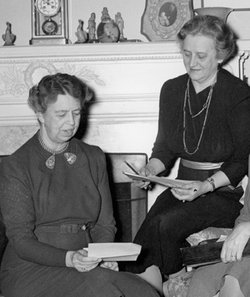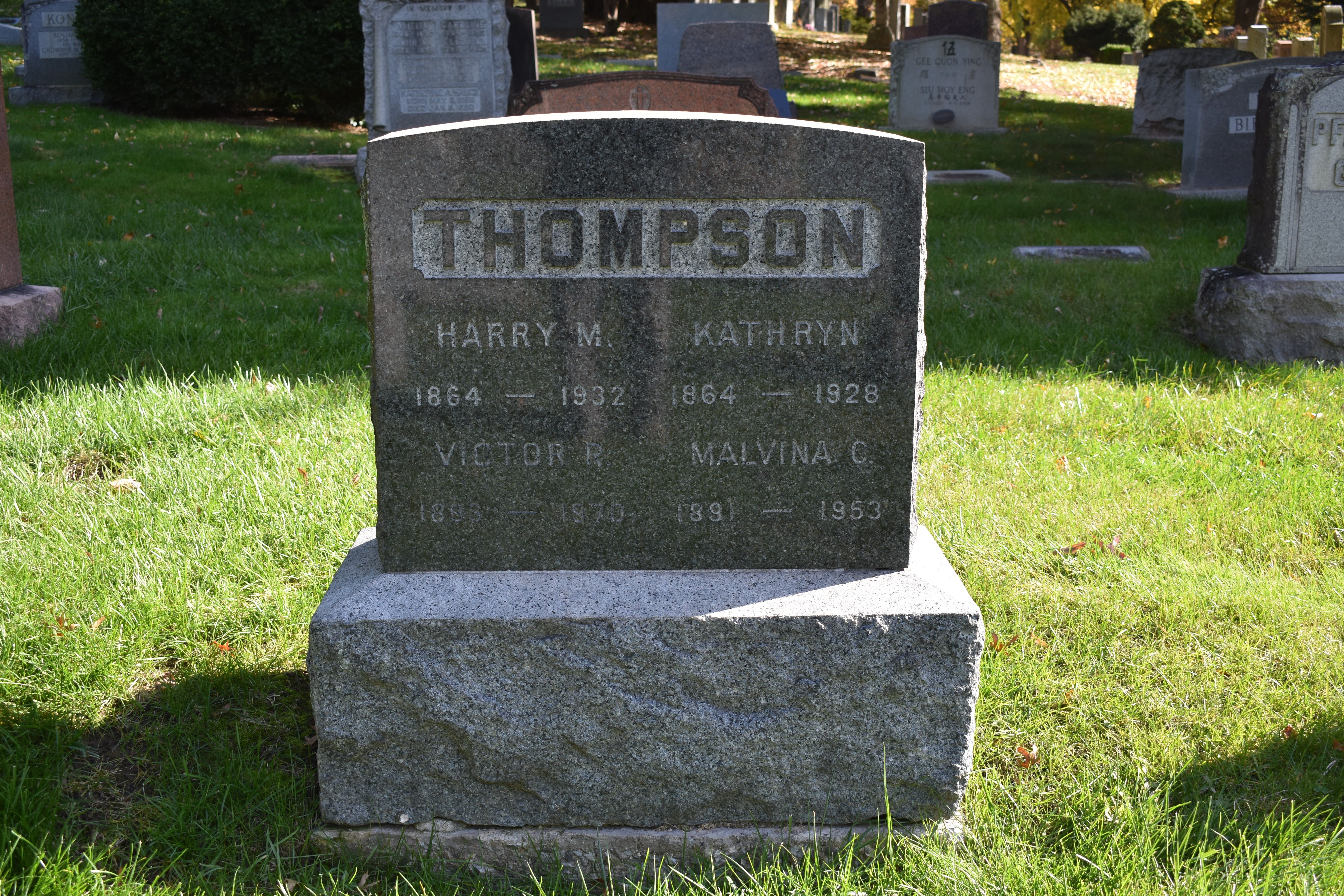Born in New York City in 1891, Thompson graduated high school and taught herself secretarial skills. In 1922, after five years with the wartime American Red Cross, Thompson joined the staff of the New York State Democratic Committee, where, working part-time, she helped Eleanor Roosevelt generate a solid women's turnout for Al Smith's 1928 presidential campaign. The two women learned their crafts together: Eleanor did not know how to dictate and Thompson did not know how to take shorthand. They quickly adjusted to each other's styles and developed such an easy working relationship that once the Smith campaign ended and Thompson began working for Louis Howe full-time, she continued to work for Eleanor part-time.
By the time they moved to the White House, the two women had built an amazing partnership and friendship. Thompson's irreverent, humorous assessment of people and events complemented Eleanor's earnestness and she could make her laugh as few others could. She was also one of the few who would say "no" to "Mrs. R." (Thompson refused to call her "Eleanor" despite requests that she do so.) A shrewd judge of character, she counterbalanced Eleanor's soft heart, often challenging her to reject a suspicious appeal or refusing to take dictation when Eleanor responded in a way that would leave her vulnerable to those who sought to exploit her generosity. She was utterly devoted to Roosevelt, and organized her life around her boss. She refused all invitations for parties and dates during her stay in the White House because of her devotion to her friend, the First Lady.
As Eleanor's key aide, Thompson traveled with her (often averaging 40,000 miles a year during the early White House years), helped organize her correspondence, typed countless "My Day" columns, often juggling her portable typewriter on her knees as she traveled by car, plane, boat, or train, and managed Eleanor's hectic schedule. She monitored Roosevelt's press conferences, critiqued her responses, and recorded key points Eleanor made when she delivered an extemporaneous speech.
Working for Eleanor was a demanding job and Thompson's devotion touched Roosevelt deeply. In 1938, when Thompson was rushed to the hospital, Eleanor cancelled all her engagements (in and out of the White House) to be at her friend's side during her hospitalization. Later that year, when Eleanor had the Val-Kill furniture factory converted into her home, she had two bedrooms, a living room, a kitchen and a screened-in porch designed for Thompson's use.
Thompson's commitment to Eleanor and her job became so intense that her marriage disintegrated. She left her husband in New York when she moved to the White House with ER (they divorced in 1938 on the grounds of voluntary separation) and refused to marry her longtime companion, Henry Osthagen, on the grounds that her job would prevent her from spending the time with him necessary to sustain a marriage. Val-Kill became as much Thompson's home as Eleanor's and Osthagen became a frequent quest. (Thompson died before Osthagen and did not a leave a will. Eleanor helped support Osthagen for the rest of his life.)
In their twenty-five year friendship, they shared holidays, family celebrations, private moments of elation and exhaustion, and trust.
"Tommy" Thompson died April 12, 1953, eight years to the day after FDR, from a brain hemorrhage (like FDR), after a 12 day hospitalization. Eleanor had rushed to the hospital from Hyde Park, where she was coordinating the wreath-laying ceremony on FDR's grave. She reached her friend's side right before her final convulsion. Eleanor was devastated; as she later wrote in "You Learn by Living" that "when she died, I learned for the first time what being alone was like."
Extracted from the "Teaching Eleanor Roosevelt Glossary" from George Washington University
Born in New York City in 1891, Thompson graduated high school and taught herself secretarial skills. In 1922, after five years with the wartime American Red Cross, Thompson joined the staff of the New York State Democratic Committee, where, working part-time, she helped Eleanor Roosevelt generate a solid women's turnout for Al Smith's 1928 presidential campaign. The two women learned their crafts together: Eleanor did not know how to dictate and Thompson did not know how to take shorthand. They quickly adjusted to each other's styles and developed such an easy working relationship that once the Smith campaign ended and Thompson began working for Louis Howe full-time, she continued to work for Eleanor part-time.
By the time they moved to the White House, the two women had built an amazing partnership and friendship. Thompson's irreverent, humorous assessment of people and events complemented Eleanor's earnestness and she could make her laugh as few others could. She was also one of the few who would say "no" to "Mrs. R." (Thompson refused to call her "Eleanor" despite requests that she do so.) A shrewd judge of character, she counterbalanced Eleanor's soft heart, often challenging her to reject a suspicious appeal or refusing to take dictation when Eleanor responded in a way that would leave her vulnerable to those who sought to exploit her generosity. She was utterly devoted to Roosevelt, and organized her life around her boss. She refused all invitations for parties and dates during her stay in the White House because of her devotion to her friend, the First Lady.
As Eleanor's key aide, Thompson traveled with her (often averaging 40,000 miles a year during the early White House years), helped organize her correspondence, typed countless "My Day" columns, often juggling her portable typewriter on her knees as she traveled by car, plane, boat, or train, and managed Eleanor's hectic schedule. She monitored Roosevelt's press conferences, critiqued her responses, and recorded key points Eleanor made when she delivered an extemporaneous speech.
Working for Eleanor was a demanding job and Thompson's devotion touched Roosevelt deeply. In 1938, when Thompson was rushed to the hospital, Eleanor cancelled all her engagements (in and out of the White House) to be at her friend's side during her hospitalization. Later that year, when Eleanor had the Val-Kill furniture factory converted into her home, she had two bedrooms, a living room, a kitchen and a screened-in porch designed for Thompson's use.
Thompson's commitment to Eleanor and her job became so intense that her marriage disintegrated. She left her husband in New York when she moved to the White House with ER (they divorced in 1938 on the grounds of voluntary separation) and refused to marry her longtime companion, Henry Osthagen, on the grounds that her job would prevent her from spending the time with him necessary to sustain a marriage. Val-Kill became as much Thompson's home as Eleanor's and Osthagen became a frequent quest. (Thompson died before Osthagen and did not a leave a will. Eleanor helped support Osthagen for the rest of his life.)
In their twenty-five year friendship, they shared holidays, family celebrations, private moments of elation and exhaustion, and trust.
"Tommy" Thompson died April 12, 1953, eight years to the day after FDR, from a brain hemorrhage (like FDR), after a 12 day hospitalization. Eleanor had rushed to the hospital from Hyde Park, where she was coordinating the wreath-laying ceremony on FDR's grave. She reached her friend's side right before her final convulsion. Eleanor was devastated; as she later wrote in "You Learn by Living" that "when she died, I learned for the first time what being alone was like."
Extracted from the "Teaching Eleanor Roosevelt Glossary" from George Washington University
Sponsored by Ancestry
Advertisement
Explore more
Sponsored by Ancestry
Advertisement



